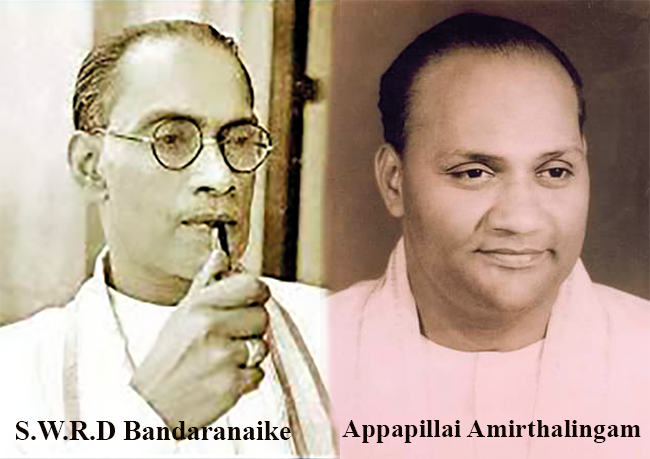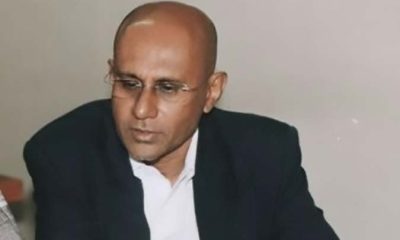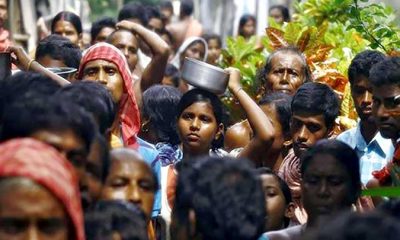Features
Amirthalingam & SWRD: Two Sides Of The Same Coin

Unleashed the same result
By Vishwamithra
Appapillai Amirthalingam
Many a book, many a sermon and many a demonstration has been written, pontificated and staged by the forces of the two sociopolitical extremes in Ceylon. They claimed to have represented the true meaning of patriotism and devotion to their racial sect. In actual fact, it was a tribal mindset that was released by man’s primordial instincts. Religion and ethnicity, time and time again, played their respective demonic role and turned once-a-cohesive society into one more divided, a country more tortured and a dual mindset more perturbed.
The Southern Appuhamy and Northern Natarajah have continued to suspect each other more than ever before. Each segment has cornered itself into a ‘comfort zone’ from which any exit to the outside world is not even pondered upon. Sinhalese, well entrenched by their religious leaders, Buddhist monks, and Tamils by their political and militant leaders.
How did this happen? How did such a peaceful people who lived under the colonial powers, Portuguese, Dutch and British, as one single nation, as one single people, resort to the most inhuman and dastardly unimaginable treatment on the other community. Adults were murdered, hacked and burnt to death while children were dashed on the ground and their mothers raped in front of her children’s eyes.
All these macabre executions were done in public for any bystander to behold; the perpetrators seemed to have enjoyed every second of their temporary indulgences. Men of both communities were totally intoxicated, not necessarily by alcohol or any other drug but by their own beliefs in a fake superiority over the other community. They cloaked their acts in pseudo-nationalism or fake patriotism. Any person who had the courage and bravado to interfere met with the same ferocity and fury of that phony patriotism.
When one attempts to trace the origins of this unfortunate and cruel fissure between the two communities, one would see 1956 for Sinhalese Buddhists and 1976 for Tamils as somewhat decisive and game-changing years.
For Sinhalese Buddhists, specifically the average not-so-privileged class, 1956 was the year in which their ‘place in the sun’ was assured. Albeit Independence was ‘won’ from British colonialism in 1948, thanks to the intense propaganda spearheaded by the left-wing parities such as the Lanka Sama Samaja Party (LSSP) and the Communist Party (CP), that Independence was merely a luxury state of affairs passed on by the British masters to the local rich and super rich class who inherited massive wealth from their parental bequeaths and consequential education abroad of Oxfordian kind.
Solomon West Ridgeway Dias Bandaranaike was one of them. Born to a wealthy, political family, he studied philosophy, politics, and economics at Christ Church, Oxford, and was called to the bar at the Inner Temple. Returning to Ceylon, he entered local politics by joining the Ceylon National Congress. Having been elected to the Colombo Municipal Council in 1926, he was elected from his family seat in Veyangoda to the State Council of Ceylon for two consecutive terms between 1931 and 1947, while serving in the second term as Minister of Local Administration in the Board of Ministers. Having founded the Sinhala Maha Sabha in 1936 on Sinhalese nationalist lines advocating for self-rule in Ceylon, he joined D S Senanayake by dissolving the Sinhala Maha Sabha and merging it with the United National Party (UNP) at its formation in 1947.
Bandaranaike was known to be a very crafty politician whose leadership was defined in reversible terms. Instead of spearheading a well disciplined crowd of men and women and leading them to a set goal along a prescribed set of national policies based on ideological grounds, he was one who identified where the followers are and led that crowd where the crowd wanted to go. Being a creation of such a mob-oriented local political stream, Bandaranaike introduced one of the most destructive political forces in the country.
‘The common man’ in 1956 was more of a slogan rather than an outcome of an empathetic feel SWRD had for the common man. He was more entrenched in his own reflection for the betterment of his own political aims. The political stream that consisted of ‘the common man‘ and the so-called ‘pancha maha balavegaya’ (five-pronged movement) was introduced which was socially destructive and divisive, economically unsustainable and morally bankrupt.
Yet he managed to draft a pact with the then Federal Party led by SJV Chelvanayakam whose enigmatic charisma continued to grow among Tamils both Northern and Eastern regions in Ceylon. Chelva, as he was fondly called, however, operated within the strict confines of non-violence. The Satyagraha campaigns organized by Chelva’s Federal Party did not bring any comfort to Tamils in the country, especially whose lives were limited to the Northern part beyond Vavuniya.
Successive governments headed by Sinhalese politicians failed to pay any attention to the hardships, both financial and cultural, suffered by Northern people. The gross negligence of Sinhalese politicians was palpable. Having failed to introduce the Bandaranaike-Chelvanayakam pact in 1957 and Dudley-Chelvanayakam pact in 1966, our leaders of yesteryear punted the ball instead of running with it and scoring a touchdown!
It was into this disappointing scenario a young lad from Pannakam near Vaddukodai in Northern province of Ceylon entered into Illankai Tamil Arasu Kachchi (Federal Party) in 1949 and became its You Front leader. His name was Appapillai Amirthalingam. In the year 1976, exactly after twenty years from the rise of Bandaranaike, Amirthalingam had become the Leader of the Opposition and the Federal Party had become the main partner of the Tamil United Liberation Front.
Even though Chelvanayakam was relatively a passive opponent, Amirthalingam had become more assertive and close to be militant in his approach to gaining concessions from any central government led by Sinhalese Buddhists. In 1972 the ITAK, ACTC (All Ceylon Tamil Congress) and others formed the Tamil United Front later renamed Tamil United Liberation Front. Amirthalingam was delivering leaflets along with other leading Tamil politicians such as M. Sivasithamparam, V. N. Navaratnam, K P Ratnam and K. Thurairatnam in 1976 when they were all arrested on government orders.
Sivasithamparam was released but the others were taken to Colombo and tried for sedition. All the defendants were acquitted after a famous Trial-at-Bar case in which 72 Tamil lawyers including SJ.V Chelvanayakam and G. G. Ponnambalam appeared for the defense. S.J.V Chelvanayakam, leader of the TULF and ITAK, died in April 1977. Amirthalingam took on the leadership of both organizations.
It was in 1975, one year before the TULF was formed, that Alfred Durraiappah, the Mayor of Jaffna, was murdered in broad daylight, presumably by a young man named Velupillai Prabhakaran. Amirthalingam’s sympathies were always with the youth in Jaffna and he clandestinely helped the militant organizations and was alleged to have been supplying both moral and financial support to the youth organizations in the peninsula. In other words, he did unleash a hitherto concealed political force in the North.
But he did not know that he himself with Yogeswaran, Jaffna MP, would become victims at the end of these youth’s guns.
In an effort to bring about unity amongst the Tamils, Yogeswaran made contact with the Liberation Tigers of Tamil Elam (LTTE) and met with them several times. He arranged a meeting between the Tamil Tigers and the TULF leaders at their Bullers Road residence. On the evening of July 13, 1989 three men, Peter Aloysius Leon (Vigna), Rasiah Aravindarajah (Visu) and Sivakumar (Arivu), arrived at the residence.
Aloysius and Visu went inside the house whilst Sivakumar remained outside. The two men met with Yogeswaran, Amirthalingam and Sivasithamparam in Yogeswaran’s apartment on the first floor. The meeting seemed to be going well when suddenly Visu pulled out a gun and shot Amirthalingam in the head and chest. Yogeswaran stood up but was shot by Aloysius and Visu. At the behest of Prabhakaran, the leadership of the TULF was eliminated.
Amirthalingam, of course, had not learnt a lesson from the Bandaranaike playbook. If one were to play tough man with militant organizations, one had to take immense precaution as to how far one could go with such organizations, terrorist or otherwise. It’s so hard to keep control of what is going to develop along the way. Instead of you controlling the momentum, the very momentum would ultimately control you. That is the sad story one has to learn from such flirtations with terrorist organizations.
Bandaranaike in 1956 never understood the power of the Pancha Maha Balavegaya and ‘the common man’. When the leadership of the Pancha Maha Balavegaya was in the hands of some thugs in saffron whose ideal is not so much consistent with that of the common man, inexperienced and self-centered men, what entails would be far too unpalatable to societal development. Bandaranaike’s pronounced ideals may have had a novel and daring appeal to the common man, but its romanticist journey will unfailingly lead to social stagnation and political instability.
As much as SWRD Bandaranaike did not learn the harder lessons of politics, neither did Amirthalingam. Both were sides of the same coin.
(This article first appeared in the Colombo Telegraph. Reproduced with the author’s permission)
Features
The heart-friendly health minister

by Dr Gotabhya Ranasinghe
Senior Consultant Cardiologist
National Hospital Sri Lanka
When we sought a meeting with Hon Dr. Ramesh Pathirana, Minister of Health, he graciously cleared his busy schedule to accommodate us. Renowned for his attentive listening and deep understanding, Minister Pathirana is dedicated to advancing the health sector. His openness and transparency exemplify the qualities of an exemplary politician and minister.
Dr. Palitha Mahipala, the current Health Secretary, demonstrates both commendable enthusiasm and unwavering support. This combination of attributes makes him a highly compatible colleague for the esteemed Minister of Health.
Our discussion centered on a project that has been in the works for the past 30 years, one that no other minister had managed to advance.
Minister Pathirana, however, recognized the project’s significance and its potential to revolutionize care for heart patients.
The project involves the construction of a state-of-the-art facility at the premises of the National Hospital Colombo. The project’s location within the premises of the National Hospital underscores its importance and relevance to the healthcare infrastructure of the nation.
This facility will include a cardiology building and a tertiary care center, equipped with the latest technology to handle and treat all types of heart-related conditions and surgeries.
Securing funding was a major milestone for this initiative. Minister Pathirana successfully obtained approval for a $40 billion loan from the Asian Development Bank. With the funding in place, the foundation stone is scheduled to be laid in September this year, and construction will begin in January 2025.
This project guarantees a consistent and uninterrupted supply of stents and related medications for heart patients. As a result, patients will have timely access to essential medical supplies during their treatment and recovery. By securing these critical resources, the project aims to enhance patient outcomes, minimize treatment delays, and maintain the highest standards of cardiac care.
Upon its fruition, this monumental building will serve as a beacon of hope and healing, symbolizing the unwavering dedication to improving patient outcomes and fostering a healthier society.We anticipate a future marked by significant progress and positive outcomes in Sri Lanka’s cardiovascular treatment landscape within the foreseeable timeframe.
Features
A LOVING TRIBUTE TO JESUIT FR. ALOYSIUS PIERIS ON HIS 90th BIRTHDAY

by Fr. Emmanuel Fernando, OMI
Jesuit Fr. Aloysius Pieris (affectionately called Fr. Aloy) celebrated his 90th birthday on April 9, 2024 and I, as the editor of our Oblate Journal, THE MISSIONARY OBLATE had gone to press by that time. Immediately I decided to publish an article, appreciating the untiring selfless services he continues to offer for inter-Faith dialogue, the renewal of the Catholic Church, his concern for the poor and the suffering Sri Lankan masses and to me, the present writer.
It was in 1988, when I was appointed Director of the Oblate Scholastics at Ampitiya by the then Oblate Provincial Fr. Anselm Silva, that I came to know Fr. Aloy more closely. Knowing well his expertise in matters spiritual, theological, Indological and pastoral, and with the collaborative spirit of my companion-formators, our Oblate Scholastics were sent to Tulana, the Research and Encounter Centre, Kelaniya, of which he is the Founder-Director, for ‘exposure-programmes’ on matters spiritual, biblical, theological and pastoral. Some of these dimensions according to my view and that of my companion-formators, were not available at the National Seminary, Ampitiya.
Ever since that time, our Oblate formators/ accompaniers at the Oblate Scholasticate, Ampitiya , have continued to send our Oblate Scholastics to Tulana Centre for deepening their insights and convictions regarding matters needed to serve the people in today’s context. Fr. Aloy also had tried very enthusiastically with the Oblate team headed by Frs. Oswald Firth and Clement Waidyasekara to begin a Theologate, directed by the Religious Congregations in Sri Lanka, for the contextual formation/ accompaniment of their members. It should very well be a desired goal of the Leaders / Provincials of the Religious Congregations.
Besides being a formator/accompanier at the Oblate Scholasticate, I was entrusted also with the task of editing and publishing our Oblate journal, ‘The Missionary Oblate’. To maintain the quality of the journal I continue to depend on Fr. Aloy for his thought-provoking and stimulating articles on Biblical Spirituality, Biblical Theology and Ecclesiology. I am very grateful to him for his generous assistance. Of late, his writings on renewal of the Church, initiated by Pope St. John XX111 and continued by Pope Francis through the Synodal path, published in our Oblate journal, enable our readers to focus their attention also on the needed renewal in the Catholic Church in Sri Lanka. Fr. Aloy appreciated very much the Synodal path adopted by the Jesuit Pope Francis for the renewal of the Church, rooted very much on prayerful discernment. In my Religious and presbyteral life, Fr.Aloy continues to be my spiritual animator / guide and ongoing formator / acccompanier.
Fr. Aloysius Pieris, BA Hons (Lond), LPh (SHC, India), STL (PFT, Naples), PhD (SLU/VC), ThD (Tilburg), D.Ltt (KU), has been one of the eminent Asian theologians well recognized internationally and one who has lectured and held visiting chairs in many universities both in the West and in the East. Many members of Religious Congregations from Asian countries have benefited from his lectures and guidance in the East Asian Pastoral Institute (EAPI) in Manila, Philippines. He had been a Theologian consulted by the Federation of Asian Bishops’ Conferences for many years. During his professorship at the Gregorian University in Rome, he was called to be a member of a special group of advisers on other religions consulted by Pope Paul VI.
Fr. Aloy is the author of more than 30 books and well over 500 Research Papers. Some of his books and articles have been translated and published in several countries. Among those books, one can find the following: 1) The Genesis of an Asian Theology of Liberation (An Autobiographical Excursus on the Art of Theologising in Asia, 2) An Asian Theology of Liberation, 3) Providential Timeliness of Vatican 11 (a long-overdue halt to a scandalous millennium, 4) Give Vatican 11 a chance, 5) Leadership in the Church, 6) Relishing our faith in working for justice (Themes for study and discussion), 7) A Message meant mainly, not exclusively for Jesuits (Background information necessary for helping Francis renew the Church), 8) Lent in Lanka (Reflections and Resolutions, 9) Love meets wisdom (A Christian Experience of Buddhism, 10) Fire and Water 11) God’s Reign for God’s poor, 12) Our Unhiddden Agenda (How we Jesuits work, pray and form our men). He is also the Editor of two journals, Vagdevi, Journal of Religious Reflection and Dialogue, New Series.
Fr. Aloy has a BA in Pali and Sanskrit from the University of London and a Ph.D in Buddhist Philosophy from the University of Sri Lankan, Vidyodaya Campus. On Nov. 23, 2019, he was awarded the prestigious honorary Doctorate of Literature (D.Litt) by the Chancellor of the University of Kelaniya, the Most Venerable Welamitiyawe Dharmakirthi Sri Kusala Dhamma Thera.
Fr. Aloy continues to be a promoter of Gospel values and virtues. Justice as a constitutive dimension of love and social concern for the downtrodden masses are very much noted in his life and work. He had very much appreciated the commitment of the late Fr. Joseph (Joe) Fernando, the National Director of the Social and Economic Centre (SEDEC) for the poor.
In Sri Lanka, a few religious Congregations – the Good Shepherd Sisters, the Christian Brothers, the Marist Brothers and the Oblates – have invited him to animate their members especially during their Provincial Congresses, Chapters and International Conferences. The mainline Christian Churches also have sought his advice and followed his seminars. I, for one, regret very much, that the Sri Lankan authorities of the Catholic Church –today’s Hierarchy—- have not sought Fr.
Aloy’s expertise for the renewal of the Catholic Church in Sri Lanka and thus have not benefited from the immense store of wisdom and insight that he can offer to our local Church while the Sri Lankan bishops who governed the Catholic church in the immediate aftermath of the Second Vatican Council (Edmund Fernando OMI, Anthony de Saram, Leo Nanayakkara OSB, Frank Marcus Fernando, Paul Perera,) visited him and consulted him on many matters. Among the Tamil Bishops, Bishop Rayappu Joseph was keeping close contact with him and Bishop J. Deogupillai hosted him and his team visiting him after the horrible Black July massacre of Tamils.
Features
A fairy tale, success or debacle

Sri Lanka-Singapore Free Trade Agreement
By Gomi Senadhira
senadhiragomi@gmail.com
“You might tell fairy tales, but the progress of a country cannot be achieved through such narratives. A country cannot be developed by making false promises. The country moved backward because of the electoral promises made by political parties throughout time. We have witnessed that the ultimate result of this is the country becoming bankrupt. Unfortunately, many segments of the population have not come to realize this yet.” – President Ranil Wickremesinghe, 2024 Budget speech
Any Sri Lankan would agree with the above words of President Wickremesinghe on the false promises our politicians and officials make and the fairy tales they narrate which bankrupted this country. So, to understand this, let’s look at one such fairy tale with lots of false promises; Ranil Wickremesinghe’s greatest achievement in the area of international trade and investment promotion during the Yahapalana period, Sri Lanka-Singapore Free Trade Agreement (SLSFTA).
It is appropriate and timely to do it now as Finance Minister Wickremesinghe has just presented to parliament a bill on the National Policy on Economic Transformation which includes the establishment of an Office for International Trade and the Sri Lanka Institute of Economics and International Trade.
Was SLSFTA a “Cleverly negotiated Free Trade Agreement” as stated by the (former) Minister of Development Strategies and International Trade Malik Samarawickrama during the Parliamentary Debate on the SLSFTA in July 2018, or a colossal blunder covered up with lies, false promises, and fairy tales? After SLSFTA was signed there were a number of fairy tales published on this agreement by the Ministry of Development Strategies and International, Institute of Policy Studies, and others.
However, for this article, I would like to limit my comments to the speech by Minister Samarawickrama during the Parliamentary Debate, and the two most important areas in the agreement which were covered up with lies, fairy tales, and false promises, namely: revenue loss for Sri Lanka and Investment from Singapore. On the other important area, “Waste products dumping” I do not want to comment here as I have written extensively on the issue.
1. The revenue loss
During the Parliamentary Debate in July 2018, Minister Samarawickrama stated “…. let me reiterate that this FTA with Singapore has been very cleverly negotiated by us…. The liberalisation programme under this FTA has been carefully designed to have the least impact on domestic industry and revenue collection. We have included all revenue sensitive items in the negative list of items which will not be subject to removal of tariff. Therefore, 97.8% revenue from Customs duty is protected. Our tariff liberalisation will take place over a period of 12-15 years! In fact, the revenue earned through tariffs on goods imported from Singapore last year was Rs. 35 billion.
The revenue loss for over the next 15 years due to the FTA is only Rs. 733 million– which when annualised, on average, is just Rs. 51 million. That is just 0.14% per year! So anyone who claims the Singapore FTA causes revenue loss to the Government cannot do basic arithmetic! Mr. Speaker, in conclusion, I call on my fellow members of this House – don’t mislead the public with baseless criticism that is not grounded in facts. Don’t look at petty politics and use these issues for your own political survival.”
I was surprised to read the minister’s speech because an article published in January 2018 in “The Straits Times“, based on information released by the Singaporean Negotiators stated, “…. With the FTA, tariff savings for Singapore exports are estimated to hit $10 million annually“.
As the annual tariff savings (that is the revenue loss for Sri Lanka) calculated by the Singaporean Negotiators, Singaporean $ 10 million (Sri Lankan rupees 1,200 million in 2018) was way above the rupees’ 733 million revenue loss for 15 years estimated by the Sri Lankan negotiators, it was clear to any observer that one of the parties to the agreement had not done the basic arithmetic!
Six years later, according to a report published by “The Morning” newspaper, speaking at the Committee on Public Finance (COPF) on 7th May 2024, Mr Samarawickrama’s chief trade negotiator K.J. Weerasinghehad had admitted “…. that forecasted revenue loss for the Government of Sri Lanka through the Singapore FTA is Rs. 450 million in 2023 and Rs. 1.3 billion in 2024.”
If these numbers are correct, as tariff liberalisation under the SLSFTA has just started, we will pass Rs 2 billion very soon. Then, the question is how Sri Lanka’s trade negotiators made such a colossal blunder. Didn’t they do their basic arithmetic? If they didn’t know how to do basic arithmetic they should have at least done their basic readings. For example, the headline of the article published in The Straits Times in January 2018 was “Singapore, Sri Lanka sign FTA, annual savings of $10m expected”.
Anyway, as Sri Lanka’s chief negotiator reiterated at the COPF meeting that “…. since 99% of the tariffs in Singapore have zero rates of duty, Sri Lanka has agreed on 80% tariff liberalisation over a period of 15 years while expecting Singapore investments to address the imbalance in trade,” let’s turn towards investment.
Investment from Singapore
In July 2018, speaking during the Parliamentary Debate on the FTA this is what Minister Malik Samarawickrama stated on investment from Singapore, “Already, thanks to this FTA, in just the past two-and-a-half months since the agreement came into effect we have received a proposal from Singapore for investment amounting to $ 14.8 billion in an oil refinery for export of petroleum products. In addition, we have proposals for a steel manufacturing plant for exports ($ 1 billion investment), flour milling plant ($ 50 million), sugar refinery ($ 200 million). This adds up to more than $ 16.05 billion in the pipeline on these projects alone.
And all of these projects will create thousands of more jobs for our people. In principle approval has already been granted by the BOI and the investors are awaiting the release of land the environmental approvals to commence the project.
I request the Opposition and those with vested interests to change their narrow-minded thinking and join us to develop our country. We must always look at what is best for the whole community, not just the few who may oppose. We owe it to our people to courageously take decisions that will change their lives for the better.”
According to the media report I quoted earlier, speaking at the Committee on Public Finance (COPF) Chief Negotiator Weerasinghe has admitted that Sri Lanka was not happy with overall Singapore investments that have come in the past few years in return for the trade liberalisation under the Singapore-Sri Lanka Free Trade Agreement. He has added that between 2021 and 2023 the total investment from Singapore had been around $162 million!
What happened to those projects worth $16 billion negotiated, thanks to the SLSFTA, in just the two-and-a-half months after the agreement came into effect and approved by the BOI? I do not know about the steel manufacturing plant for exports ($ 1 billion investment), flour milling plant ($ 50 million) and sugar refinery ($ 200 million).
However, story of the multibillion-dollar investment in the Petroleum Refinery unfolded in a manner that would qualify it as the best fairy tale with false promises presented by our politicians and the officials, prior to 2019 elections.
Though many Sri Lankans got to know, through the media which repeatedly highlighted a plethora of issues surrounding the project and the questionable credentials of the Singaporean investor, the construction work on the Mirrijiwela Oil Refinery along with the cement factory began on the24th of March 2019 with a bang and Minister Ranil Wickremesinghe and his ministers along with the foreign and local dignitaries laid the foundation stones.
That was few months before the 2019 Presidential elections. Inaugurating the construction work Prime Minister Ranil Wickremesinghe said the projects will create thousands of job opportunities in the area and surrounding districts.
The oil refinery, which was to be built over 200 acres of land, with the capacity to refine 200,000 barrels of crude oil per day, was to generate US$7 billion of exports and create 1,500 direct and 3,000 indirect jobs. The construction of the refinery was to be completed in 44 months. Four years later, in August 2023 the Cabinet of Ministers approved the proposal presented by President Ranil Wickremesinghe to cancel the agreement with the investors of the refinery as the project has not been implemented! Can they explain to the country how much money was wasted to produce that fairy tale?
It is obvious that the President, ministers, and officials had made huge blunders and had deliberately misled the public and the parliament on the revenue loss and potential investment from SLSFTA with fairy tales and false promises.
As the president himself said, a country cannot be developed by making false promises or with fairy tales and these false promises and fairy tales had bankrupted the country. “Unfortunately, many segments of the population have not come to realize this yet”.
(The writer, a specialist and an activist on trade and development issues . )
























